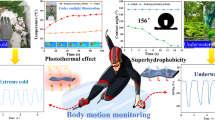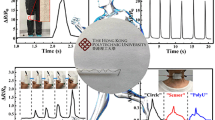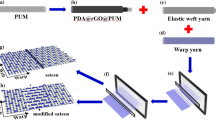Abstract
Recently, soft and stretchable strain sensors that can be incorporated into textiles have attracted significantly increasing interest for use in a diverse range of applications. However, the simple fabrication of stretchable devices that exhibit excellent sensing performance, are highly durability and are a good fit to the human body remains a challenge. Herein, we describe the fabrication of a new flexible strain sensor on a traditional polyester fabric using a one-step method that involves the reduction of graphene oxide (GO) using ascorbic acid (L-AA). The resulting textile-based strain sensors could be washed, exhibited long-term stability, and had a negative linear response that gave a good sensing response when used in wearable applications. In addition to effectively detecting human motions, the textile was modified such that it could detect ultra-large deformations. The impressive mechanical performance, durability and the ability to capture and monitor a variety of human actions and motions mean that these textile-based sensors have great potential in biomonitoring, soft co-robotics, and human-machine interactions.
Similar content being viewed by others
References
Fu Y, Wu H, Ye S, et al. Integrated power fiber for energy conversion and storage. Energy Environ Sci, 2013, 6: 805–812
Jost K, Dion G, Gogotsi Y. Textile energy storage in perspective. J Mater Chem A, 2014, 2: 10776–10787
Pu X, Liu M, Li L, et al. Wearable textile-based in-plane micro-supercapacitors. Adv Energy Mater, 2016, 6: 1601254
Zhu J, Tang S, Wu J, et al. Wearable high-performance super-capacitors based on silver-sputtered textiles with FeCo2S4-NiCo2S4 composite nanotube-built multitripod architectures as advanced flexible electrodes. Adv Energy Mater, 2016, 7: 1601234
Lund A, Rundqvist K, Nilsson E, et al. Energy harvesting textiles for a rainy day: Woven piezoelectrics based on melt-spun pvdf microfibres with a conducting core. NPJ Flex Electron, 2018, 2: 9
Ryan J D, Mengistie D A, Gabrielsson R, et al. Machine-washable PEDOT:PSS dyed silk yarns for electronic textiles. ACS Appl Mater Interfaces, 2017, 9: 9045–9050
Wen Z, Yeh M H, Guo H, et al. Self-powered textile for wearable electronics by hybridizing fiber-shaped nanogenerators, solar cells, and supercapacitors. Sci Adv, 2016, 2: e1600097
Hamedi M, Forchheimer R, Inganäs O. Towards woven logic from organic electronic fibres. Nat Mater, 2007, 6: 357–362
Müller C, Hamedi M, Karlsson R, et al. Woven electrochemical transistors on silk fibers. Adv Mater, 2011, 23: 898–901
Jo A, Seo Y, Ko M, et al. Textile resistance switching memory for fabric electronics. Adv Funct Mater, 2017, 27: 1605593
Takamatsu S, Lonjaret T, Ismailova E, et al. Wearable keyboard using conducting polymer electrodes on textiles. Adv Mater, 2016, 28: 4485–4488
Zhao Z, Yan C, Liu Z, et al. Machine-washable textile triboelectric nanogenerators for effective human respiratory monitoring through loom weaving of metallic yarns. Adv Mater, 2016, 28: 10267–10274
Takamatsu S, Yamashita T, Imai T, et al. Lightweight flexible keyboard with a conductive polymer-based touch sensor fabric. Sens Actuat A-Phys, 2014, 220: 153–158
Lee J, Kwon H, Seo J, et al. Conductive fiber-based ultrasensitive textile pressure sensor for wearable electronics. Adv Mater, 2015, 27: 2433–2439
Guo X, Huang Y, Cai X, et al. Capacitive wearable tactile sensor based on smart textile substrate with carbon black/silicone rubber composite dielectric. Meas Sci Technol, 2016, 27: 045105
Nazmul K, Shaila A, Andromachi M. All inkjet-printed graphene-based conductive pattern for wearable e-textiles application. J Mater Chem C, 2017, 5: 11640–11648
Zhong W, Liu C, Xiang C, et al. Continuously producible ultrasensitive wearable strain sensor assembled with three-dimensional interpenetrating agnw/poe nanofibrous composite yarn. ACS Appl Mater Interfaces, 2017, 9: 42058–42066
Li Y, Li Y, Su M, et al. Electronic textile by dyeing method for multiresolution physical kineses monitoring. Adv Electron Mater, 2017, 3: 1700253
Chen S, Liu S, Wang P, et al. Highly stretchable fiber-shaped e-textiles for strain/pressure sensing, full-range human motions detection, health monitoring, and 2D force mapping. J Mater Sci, 2018, 53: 2995–3005
Yan T, Wang Z, Pan Z J. A highly sensitive strain sensor based on a carbonized polyacrylonitrile nanofiber woven fabric. J Mater Sci, 2018, 53: 11917–11931
Yin F, Yang J, Peng H, et al. Flexible and highly sensitive artificial electronic skin based on graphene/polyamide interlocking fabric. J Mater Chem C, 2018, 6: 6840–6846
Karim N, Afroj S, Malandraki A, et al. All inkjet-printed graphene-based conductive patterns for wearable e-textile applications. J Mater Chem C, 2017, 5: 11640–11648
Du D, Tang Z, Ouyang J. Highly washable e-textile prepared by ultrasonic nanosoldering of carbon nanotubes onto polymer fibers. J Mater Chem C, 2018, 6: 883–889
Kim S J, Song W, Yi Y, et al. High durability and waterproofing rGO/SWCNT-fabric-based multifunctional sensors for human-motion detection. ACS Appl Mater Interfaces, 2018, 10: 3921–3928
Wu H, Liu Q, Chen H, et al. Fibrous strain sensor with ultra-sensitivity, wide sensing range, and large linearity for full-range detection of human motion. Nanoscale, 2018, 10: 17512–17519
Cai G, Yang M, Pan J, et al. Large-scale production of highly stretchable CNT/cotton/spandex composite yarn for wearable applications. ACS Appl Mater Interfaces, 2018, 10: 32726–32735
Gao J, Wang X, Zhai W, et al. Ultrastretchable multilayered fiber with a hollow-monolith structure for high-performance strain sensor. ACS Appl Mater Interfaces, 2018, 10: 34592–34603
Liu M, Pu X, Jiang C, et al. Large-area all-textile pressure sensors for monitoring human motion and physiological signals. Adv Mater, 2017, 29: 1703700
Cai Y, Shen J, Dai Z, et al. Extraordinarily stretchable all-carbon collaborative nanoarchitectures for epidermal sensors. Adv Mater, 2017, 29: 1606411
Ye X, Yuan Z, Tai H, et al. A wearable and highly sensitive strain sensor based on a polyethylenimine-rGO layered nanocomposite thin film. J Mater Chem C, 2017, 5: 7746–7752
Zeng Z, Seyed Shahabadi S I, Che B, et al. Highly stretchable, sensitive strain sensors with a wide linear sensing region based on compressed anisotropic graphene foam/polymer nanocomposites. Nanoscale, 2017, 9: 17396–17404
Yang Z, Pang Y, Han X, et al. Graphene textile strain sensor with negative resistance variation for human motion detection. ACS Nano, 2018, 12: 9134–9141
Zhang J, Yang H, Shen G, et al. Reduction of graphene oxide via l-ascorbic acid. Chem Commun, 2010, 46: 1112–1114
Sheng K, Xu Y, Li C, et al. High-performance self-assembled graphene hydrogels prepared by chemical reduction of graphene oxide. New Carbon Mater, 2011, 26: 9–15
Fernández-Merino M J, Guardia L, Paredes J I, et al. Vitamin C is an ideal substitute for hydrazine in the reduction of graphene oxide suspensions. J Phys Chem C, 2010, 114: 6426–6432
Hempel M, Nezich D, Kong J, et al. A novel class of strain gauges based on layered percolative films of 2D materials. Nano Lett, 2012, 12: 5714–5718
Jiang L, Fan Z. Design of advanced porous graphene materials: From graphene nanomesh to 3D architectures. Nanoscale, 2014, 6: 1922–1945
Zhao J, Wang G, Yang R, et al. Tunable piezoresistivity of nanographene films for strain sensing. ACS Nano, 2015, 9: 1622–1629
Souri H, Bhattacharyya D. Highly stretchable multifunctional wearable devices based on conductive cotton and wool fabrics. ACS Appl Mater Interfaces, 2018, 10: 20845–20853
Seyedin S, Razal J M, Innis P C, et al. Knitted strain sensor textiles of highly conductive all polymeric fibers. ACS Appl Mater Interfaces, 2015, 7: 21150–21158
Author information
Authors and Affiliations
Corresponding author
Additional information
This work was supported by the National Science Funds for Excellent Young Scholars of China (Grant No. 61822106), National Science Funds for Creative Research Groups of China (Grant No. 61421002) and National Natural Science Foundation of China (Grant No. 61671115).
Electronic Supplementary Material
Rights and permissions
About this article
Cite this article
Sun, T., Jiang, Y., Duan, Z. et al. Wearable and washable textile-based strain sensors via a single-step, environment-friendly method. Sci. China Technol. Sci. 64, 441–450 (2021). https://doi.org/10.1007/s11431-019-1567-y
Received:
Accepted:
Published:
Issue Date:
DOI: https://doi.org/10.1007/s11431-019-1567-y




